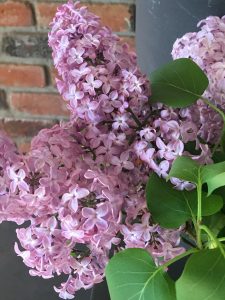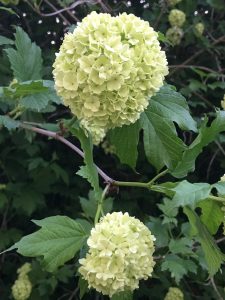
I have been researching possible candidates for wholesale cultivation for the cut flower market this week. Two woody shrubs that I am interested in growing are Syringa, better known as lilac, and Viburnum, commonly called snowball bush.

There are over one hundred species of viburnum. Most have one or more ornamental traits that that make them a desirable choice for wholesale production. Viburnums are easy to grow in the pacific northwest, optimal growing conditions are moist acidic soil. Viburnum acerifolium, mapleleaf viburnum is a native to eastern North America. It grows best in heavy shade. It produces stunning fall foliage in shades of pink, red, and purple.
Pros
- Many early flowering species have highly fragrant flowers.
- Several cultivars produce colorful fruits or striking fall foliage.
- Snowball viburnum is among the top ten bestsellers in the cut flower market.
Cons
- Fragrant species have a short vase life.
- Harvesting for fall fruit can only be done biennially
Lilac Syringa
Lilac is also one of the top ten sellers, stems command a good price. It does not ship well, this makes it a good choice for the local market, with little competition from international conventional grower.
Lilacs perform best in a sunny location with well drained soil and ph levels between 6 and 7.5. They need to be fertilized in late fall and again after flowering, with a nitrogen, phosphorus, and potassium ratio of 1-3-5. High nitrogen concentrations must be avoided to produce flowering.
Bacterial blight occurs in spring when there are mild temperatures and wet weather. Symptoms of lilac blight are similar in appearance to fire blight in fruit trees. The flowers wilt, turn brown, and unopened flower buds turn black. The disease starts as brown spots on the stems and leaves of young shoots in the spring. The spots become black and spread rapidly in warm wet conditions. Recommended species for the northwest that are resistant to bacterial blight include: S. josikaea, S. Lomarowii, S. microphylla, S. perinensis, and S. reflexa.
Pros
- Lilac thrives in the northern regions.
- Fragrant flowers in shades of blue, pink, lilac, and white, singles or double flowers.
- Once established plants can last for decades with minimal maintenance.
Cons
- Plants have a long juvenile period before production.
- Stems have hard wood and are difficult to hydrate.
- Vase life is short, an average of five days.